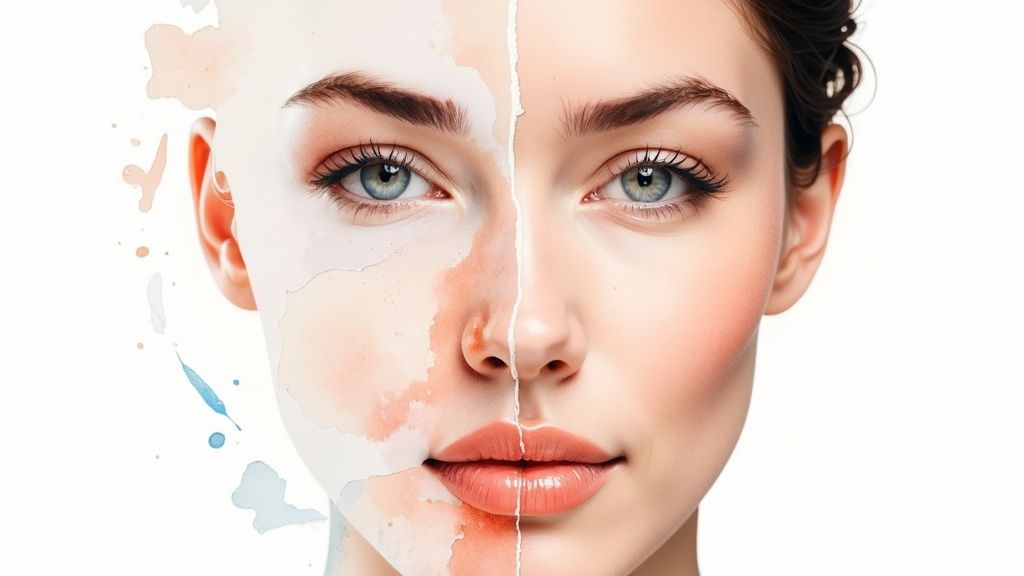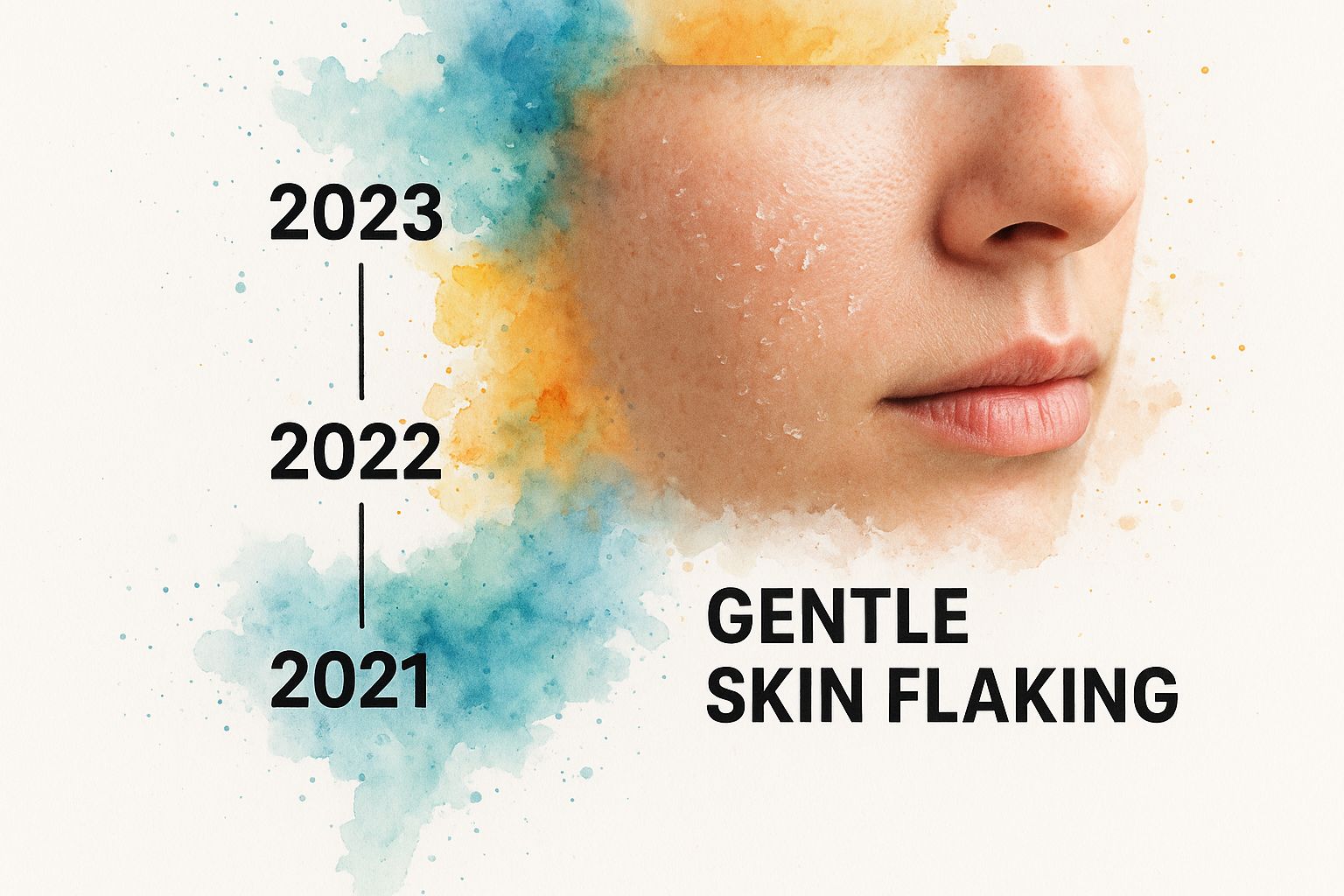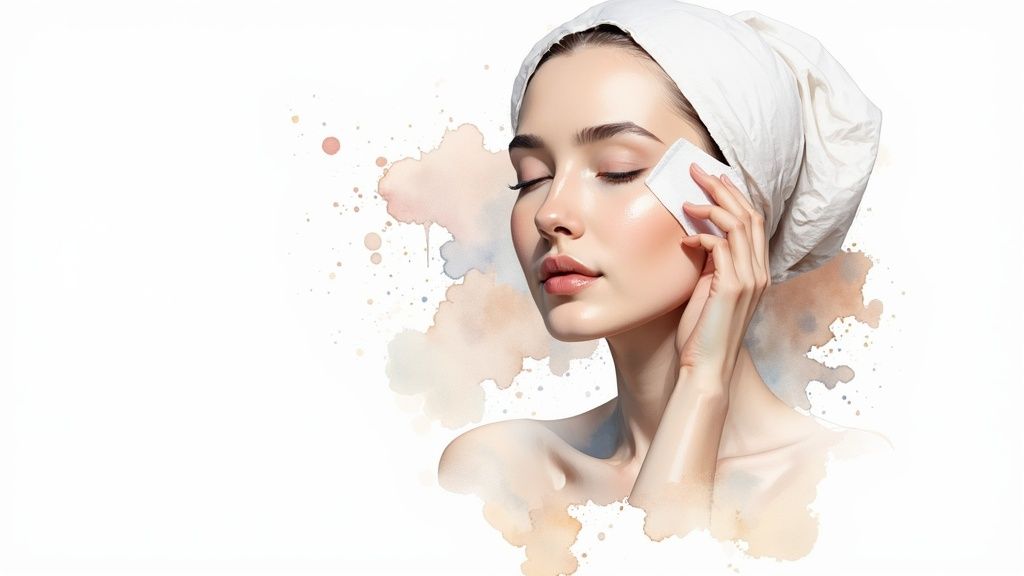
What to Expect After a Chemical Peel Explained
Alright, let's get into what you can really expect in those first crucial hours after your chemical peel. The moment you leave the clinic, your skin has already started its healing journey.
Immediately after the treatment, your face will likely feel tight and look a bit flushed, kind of like you got a little too much sun. This initial 24-hour window is absolutely critical. Think of it as setting the foundation for your final results.
Your First 24 Hours After a Chemical Peel
So, the treatment is done. Now what? Imagine your skin is a delicate, brand-new surface. It's incredibly sensitive and needs to be babied so it can heal beautifully. How you treat it on this first day really dictates the entire recovery process.
You'll probably feel some tightness, warmth, and notice visible redness. Don't panic—this is a good thing! It's just the normal inflammatory response kicking in, which tells you the skin's renewal engine has turned on. The intensity of these sensations really depends on the strength of your peel. A light peel might feel like a minor sunburn, while a deeper one will obviously feel more significant.
Immediate Do's and Don'ts
Your number one job right now is to keep your skin calm and protected. That means sticking to a very simple, very specific routine.
- Do Use a Gentle Cleanser: When you wash your face, use only cool water and a very mild, soap-free cleanser that your practitioner recommended. Pat, don't scrub.
- Do Apply Recommended Moisturizer: Your provider will have a specific soothing balm or hydrating cream for you. Slather it on. This keeps your skin barrier happy and hydrated.
- Do Stay Indoors: I can't stress this enough: sun avoidance is completely non-negotiable. UV rays hitting that vulnerable new skin can cause a world of hurt, from serious irritation to post-inflammatory hyperpigmentation.
If you remember only one thing for the first 24 hours, let it be this: less is more. Don't touch your skin, keep it out of the sun, and only use the products your specialist gave you.
Now, let's talk about what not to do. Avoiding certain things is just as important as what you put on your face. Getting this wrong can derail your results and lead to complications you definitely don't want.
What to Strictly Avoid
Here's a quick rundown of the big no-nos for day one.
- No Exfoliants or Active Ingredients: Put away anything with retinoids, alpha-hydroxy acids (AHAs), beta-hydroxy acids (BHAs), or even vitamin C for now.
- Avoid Heat and Sweat: That means no tough workouts, saunas, steam rooms, or super hot showers. Getting sweaty and flushed will only increase inflammation and make you more uncomfortable.
- Don't Pick or Peel: While true peeling probably hasn't started yet, get in the mindset of keeping your hands off. Resisting the urge to touch, rub, or pick at your face is key to preventing scars and ensuring everything heals evenly.
By handling this first day with care, you’re giving your skin the head start it needs for a smooth recovery and amazing results.
What to Expect: Your Day-by-Day Healing and Peeling Timeline
Alright, you’ve made it through the first 24 hours. Now the real action begins. This next phase is often the most dramatic visually, but knowing what's coming can make the whole experience feel a lot less daunting. Think of it as your skin getting rid of its old, tired outer layer to make way for a fresh start.
The initial redness and tightness will soon give way to a feeling of pronounced dryness. This isn't a bad sign—it's the signal that the peeling process is right around the corner. Your job right now is simply to keep your skin moisturized and protected. Let it do its thing.
Days 2-3: The Skin Starts to Shift
Around day two, you'll likely notice your skin looks a bit darker in some areas. It will also feel incredibly tight, almost like you're wearing a mask. This is just the damaged, outermost layer of skin preparing to lift away from the healthy, new skin that’s forming underneath.
By day three, the flaking usually begins. From what we see in the clinic, this is the most common starting point for peeling, especially after a medium-depth peel. It typically starts around the parts of your face that move the most, like around your mouth and chin, and then works its way outwards. The number one rule here? Do not pick or pull at the skin! Resisting the urge is critical to prevent scarring or creating dark spots.

As you can see, the peeling process isn't a one-and-done event. It’s a gradual shedding that allows the delicate new skin underneath to mature and strengthen at its own pace.
To give you a clearer picture, here’s a breakdown of what you can generally expect during that first week of healing after a medium-depth peel.
Typical Healing Stages After a Medium Chemical Peel
| Timeframe | What Your Skin Looks Like | What Your Skin Feels Like |
|---|---|---|
| Days 1-2 | Red, slightly swollen, and possibly darker or bronzed. | Tight, sensitive, and very dry. |
| Days 3-4 | Flaking and peeling begin, often around the mouth and nose. | Itchy and tight as the old skin starts to lift. |
| Days 5-6 | Peeling is at its peak. Larger flakes or sheets may come off. | Dryness and some irritation under the peeling skin. |
| Day 7+ | Peeling subsides, revealing fresh, pink, smooth skin underneath. | Skin feels smoother but is still sensitive and delicate. |
Remember, this timeline is a general guide. Everyone's skin heals a little differently, so don't worry if your experience varies slightly.
Days 4-5: Welcome to Peak Peeling
This is when your skin is at its most active. During days four and five, the peeling will hit its peak. You’ll see more significant sheets of skin shedding, especially from larger areas like your cheeks and forehead. It might not be the prettiest sight, but it's a fantastic sign that the peel is doing exactly what it's supposed to do.
During this peak phase, your aftercare is simple but non-negotiable:
- Cleanse Gently: Use only your fingertips and a super-mild cleanser to wash your face. No washcloths, no scrubs.
- Moisturize Constantly: Apply a thick, soothing moisturizer as often as needed to manage the dryness and keep your skin comfortable.
- Protect from the Sun: This is the most important step. Your new skin is incredibly vulnerable. A broad-spectrum sunscreen with at least SPF 30 is an absolute must, even if you're just sitting by a window indoors.
Here's the most important thing to remember: That peeling skin is nature's bandage, protecting the brand-new skin forming beneath it. Pulling it off early is like picking a scab—it disrupts the healing process and can lead to scarring and other issues.
Days 6-7: The Final Stretch
By the time you get to day six or seven, the most intense part of the peeling should be winding down. You’ll start to see beautiful patches of smooth, fresh, and glowing new skin emerge. Any lingering redness will begin to fade, revealing a complexion that looks much more even and refined.
Even though the worst of the peeling is over, your skin is still very delicate. Stick with your gentle aftercare routine and continue to avoid any harsh products, exfoliants, or intensive treatments. Getting familiar with the full recovery process is key, which is why we've put together a complete guide on what to expect during chemical peel downtime.
By the end of this first week, you're well on your way to seeing the fantastic results of all your patience and care.
Light, Medium, and Deep Peels: How Your Recovery Changes
Not all chemical peels are the same, and your recovery journey will look completely different depending on how deep the treatment goes. Think of it like refinishing a piece of furniture—a light buffing just polishes the surface, but a deep sanding gets down to the raw wood and takes a lot more time and care to get that perfect finish.
Your skin works the same way. The deeper the peel, the more intense the healing process, which means more peeling, more redness, and a longer wait to see those incredible final results. Let's break down what that really looks like.
Chemical Peel Recovery At a Glance
To give you a clearer picture, here’s a quick comparison of what to expect from the three main types of chemical peels.
| Peel Depth | Typical Downtime | Peeling Intensity | Key Aftercare Steps |
|---|---|---|---|
| Light Peel | 1-3 days | Mild flaking, if any | Gentle cleanser, moisturizer, daily SPF 30+ |
| Medium Peel | 5-7 days | Moderate sheet peeling | Strict sun avoidance, heavy ointments, no picking |
| Deep Peel | 14+ days | Intense shedding/crusting | Medicated soaks, antiviral meds, long-term sun protection |
As you can see, the commitment level for aftercare ramps up significantly with the depth of the peel.
The Light Peel Experience
This is what we call a "lunchtime peel," and for good reason. It only touches the very top layer of your skin (the epidermis), making recovery incredibly straightforward.
- Downtime: You'll probably have some minor redness for a few hours, but most people head right back to their normal routine.
- Sensation: Your skin might feel a little tight or dry for a day or so, but nothing major.
- Peeling: Expect some light flaking, kind of like dandruff. It's often so minimal that no one else will even notice.
A light peel is perfect when you just need a quick reset for dullness or minor texture issues. You can get one on a Friday and look fantastic by Monday.
The Medium Peel Recovery Journey
Okay, now we're getting into more noticeable territory. A medium-depth peel goes a bit deeper, reaching the upper part of the dermis. This is what makes it so effective for fine lines, stubborn pigmentation, and uneven texture.
Because it works on a deeper level, your skin’s healing response is much more dramatic. You should plan for a few days of social downtime where you'll see visible peeling. The initial redness is stronger and can last a couple of days before the skin starts to shed in larger sheets. You have to be patient and stick to your aftercare routine, but the smooth, clear skin underneath is worth it.
The real difference is in the healing intensity. A light peel gives your skin a gentle nudge to refresh itself, while a medium peel forces a much bigger, more visible shedding process for a more significant payoff.
The Deep Peel: An Intensive Healing Process
A deep chemical peel, usually done with an ingredient called phenol, is the most powerful peel out there. It reaches into the lower layers of the dermis to correct deep-set wrinkles, major sun damage, and even some precancerous spots. As you can imagine, the recovery is a serious commitment.
The timeline for healing after a peel changes drastically with its depth. Superficial peels might leave you a bit red, but you'll see improvement within 3 to 7 days. Medium peels, on the other hand, bring on more redness, swelling, and significant peeling that can last 7 to 14 days. For deep peels, you're looking at a recovery of 14 to 21 days or more, which involves heavy crusting and peeling. For these, your dermatologist will likely prescribe antiviral medications and insist on zero sun exposure to make sure you heal correctly. You can find more expert advice on the peel recovery process at hovecenter.com.
This is a serious medical procedure, and the aftercare is non-negotiable. It involves:
- Significant Downtime: Plan on staying home and focusing on recovery for at least two weeks.
- Intensive Aftercare: Your regimen will likely include medicated ointments, special skin soaks, and avoiding the sun like the plague for several months.
- Visible Healing: Expect a lot of swelling, redness, and crusting before the actual peeling starts.
The recovery is intense, there's no sugarcoating it. But the results from a deep peel can be truly life-changing, offering a complete resurfacing of your skin that can last for years.
Essential Aftercare for The Best Possible Results

The success of your chemical peel doesn't just hinge on what happens in the treatment room. What you do at home in the days following is just as critical. Proper aftercare is the crucial link between the procedure and the glowing, refreshed skin you're after.
Think of your skin post-peel as a delicate new seedling. It's incredibly fragile and needs the right environment—gentle nourishment, plenty of moisture, and serious protection—to flourish. This means stripping your routine back to the absolute bare essentials. Now is not the time for your 10-step regimen.
The Golden Rules of Post-Peel Care
The entire goal is simple: keep your new skin calm, hydrated, and protected. Anything that could introduce friction, irritation, or inflammation is off the table for now.
- Keep it Simple: Use only a mild, soap-free cleanser with lukewarm water. When you’re done, gently pat your skin dry with a soft, clean towel. No rubbing allowed!
- Moisturize Generously: Your skin's protective barrier is temporarily compromised, which means it loses moisture easily. A thick, soothing, fragrance-free moisturizer is your new best friend. Apply it often throughout the day to keep your skin from feeling tight and dry.
- Hydrate from Within: Your skin heals from the inside out, so keep your water bottle handy. Aiming for at least eight glasses a day really does support the recovery process.
To give your skin an extra healing boost, you might look into complementary therapies. For example, Red Light Therapy is well-regarded for its Red Light Therapy benefits for skin and pain relief. And for a complete, easy-to-follow list, be sure to check out our detailed https://oliveskintherapy.com/post/chemical-peel-aftercare-instructions to make sure you've got all your bases covered.
Your Most Important Job: Sun Protection
If there is one absolute, non-negotiable rule after a chemical peel, it’s this: protect your skin from the sun. Your fresh, new skin is extremely susceptible to UV damage. Sun exposure during this time can quickly trigger serious problems like post-inflammatory hyperpigmentation (dark spots) or even scarring, completely reversing the benefits of your treatment.
Think of sunscreen as a dedicated bodyguard for your new skin cells. It's the most critical piece of your aftercare puzzle, shielding the delicate, regenerating tissue from the UV radiation that can sabotage your results.
You need to apply a broad-spectrum mineral sunscreen with an SPF of at least 30 every single morning. Do this even if you’re staying inside, as UV rays still penetrate windows. If you're outdoors, reapply it every two hours without fail. This isn't just a friendly tip—it's essential for protecting your investment.
What to Avoid During Recovery
What you don't do is just as important as what you do. For at least a week (or until your skincare professional gives you the green light), you must steer clear of certain products and activities.
- Strenuous Exercise: Getting hot and sweaty can dial up inflammation and redness. Give your intense workouts a rest for a few days.
- Hot Showers and Saunas: That lovely steam and heat will only strip your skin’s natural oils and cause more irritation. Keep your showers cool or lukewarm for now.
- Active Ingredients: It’s time to press pause on your retinoids, vitamin C serums, and any exfoliating acids (like AHAs and BHAs). Reintroducing these powerful ingredients too soon can trigger a nasty reaction and set your healing way back.
Seeing Your Final Results and Maintaining Them

After carefully navigating the healing process, the moment you’ve been waiting for finally arrives. Seeing your final results is incredibly rewarding, but the timeline for that big reveal really depends on the strength of your peel.
If you had a light peel, you’ll probably notice an immediate glow and a smoother texture as soon as the initial flaking stops, which is usually within a week. For medium and deep peels, it's more of a marathon than a sprint. You'll see some major improvements once the heavy peeling is over—around the 7-14 day mark—but the real transformation unfolds over the next few months as new collagen builds, firming up your skin and softening fine lines.
When Will My Skin Look Its Best?
That initial fresh-faced look is fantastic, but it’s just the beginning. Your skin's appearance will continue to improve for weeks, and sometimes even months, after the initial healing is done.
- 1-2 Weeks Post-Peel: The most obvious peeling and redness should be gone. Your skin will already look brighter, feel smoother, and have a more even tone.
- 1 Month Post-Peel: By now, your skin has really settled in. Your complexion looks clearer and the texture is much more refined as your collagen production kicks into a higher gear.
- 3-6 Months Post-Peel: This is the sweet spot for medium and deep peels. You'll see the peak results now—firmer skin, noticeably softer lines, and a significant reduction in stubborn pigmentation.
The patience you practice during the peeling phase pays off tenfold in the months that follow. The initial glow you see is just the beginning; the deeper, structural improvements take time to fully develop.
Protecting and Extending Your Results
Getting that beautiful result is one thing, but keeping it is the real goal. Protecting your investment means committing to a smart, long-term skincare strategy. Think of it as shifting from a short-term recovery plan to a long-term nourishment and defense routine.
Sun protection is your absolute number one priority. Using a broad-spectrum SPF 30+ every single day is non-negotiable. This is what will prevent new sun damage from undoing all your hard work.
Beyond sunscreen, your daily routine should focus on supporting your skin’s health. Here’s what that looks like:
- A Gentle Cleanser: Stick with a mild, pH-balanced cleanser that won’t strip your skin’s protective barrier.
- Hydrating Serums: Ingredients like hyaluronic acid are fantastic for helping your skin hold onto moisture, keeping it plump and happy.
- Antioxidants: A good vitamin C serum each morning is like a shield against environmental stressors and free radicals.
- Retinoids (When Ready): Once your provider gives you the all-clear (usually after about a month), reintroducing a retinoid can help maintain that healthy cell turnover and keep collagen production going.
The visible changes can be stunning, and it’s motivating to see some incredible chemical peel before and after results that transform skin to understand what’s possible. By committing to a consistent and protective skincare routine, you’re ensuring those gorgeous, luminous results stick around for a long, long time.
Your Top Chemical Peel Recovery Questions, Answered
Going through the healing process after a chemical peel can feel a bit mysterious, and it’s natural to have a lot of questions pop up. Knowing what to expect makes the whole experience feel less daunting and a lot more manageable.
Think of this phase as a partnership between you and your skin. Your skin is doing the heavy lifting of regeneration, and your job is to give it the support it needs by following your aftercare plan. Let's tackle some of the most common concerns people have.
Can I Wear Makeup After a Chemical Peel?
This is probably the number one question we hear, and the answer is a firm but gentle "not just yet." Your skin needs a break. You should wait until the peeling process is completely finished and that fresh, new skin underneath has had a chance to surface and strengthen. For a medium peel, that usually means waiting 7 to 14 days.
Why the wait? Applying makeup too soon can trap bacteria against your vulnerable new skin, leading to breakouts or, worse, irritation and infection. Your fresh skin needs to breathe to heal properly. Now, for very light "lunchtime" peels, you might get the green light for a breathable mineral makeup after a day or two, but always check with your provider first.
What Should I Do If My Skin Is Super Itchy?
Itching is a totally normal—and admittedly, very annoying—part of the healing journey. It’s a sign that your old skin is drying up and new skin is forming. The golden rule here is simple: do not scratch. Seriously, resist the urge.
Here are a few ways to get some relief without damaging your results:
- Cool It Down: A clean, soft washcloth dipped in cool water and gently pressed onto the itchy spots can be incredibly soothing.
- Moisturize, Moisturize, Moisturize: A good, gentle moisturizer is your best friend right now. Dry skin is itchy skin, so keeping it hydrated is the best way to keep the itchiness at bay.
- Keep Your Cool: Try to avoid hot showers, saunas, or intense workouts that make you sweat. Heat and sweat can make that itching sensation feel ten times worse.
If the itching feels intense or unbearable, give your dermatologist a call. They can help.
Annoying as it is, that itchy feeling is actually a good sign. It means your skin's nerve endings are waking up as the healing process kicks into gear. It’s a positive signal that things are moving in the right direction.
Is It Normal for Some Areas to Peel More Than Others?
Absolutely. Your face isn't a uniform canvas; skin thickness and oiliness vary from your forehead to your chin. It’s very common for areas with a lot of movement—like around your mouth from talking and eating—to start peeling first.
You’ll likely see the peeling happen in patches or waves, not all at once. Your nose might start shedding on day three, while your forehead holds on until day five. This uneven pattern is just part of the natural process and everything will even out by the end of your recovery week.
When Can I Use My Regular Skincare Products Again?
You'll need to hit pause on your usual powerhouse products for a bit. Anything with active ingredients like retinoids (Retin-A, retinol), vitamin C serums, and exfoliating acids (glycolic, salicylic) is off-limits for now. They are far too strong for your delicate, new skin and can cause major irritation, redness, and set your healing back.
A good rule of thumb is to wait at least two weeks after a light or medium peel before slowly reintroducing your old routine. When you do, bring back one product at a time over a few days to make sure your skin is ready for it. If you have questions about other treatments that might complement your results down the line, you can explore a range of facial options available on Long Island.
At Olive Skin Therapy, we're dedicated to guiding you through every step of your skincare journey, from treatment to full recovery. Discover how our customized chemical peels can help you achieve your skin goals by visiting us at https://oliveskintherapy.com.
